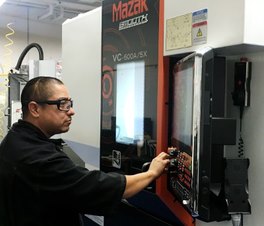NIMS Scholarship Awarded to SBVC to Fund State-of-the-Art Equipment
 In just 18 weeks or less, students at San Bernardino Valley College can prepare for
high demand fields, some old-style machining and some are new style cutting edge CNC
(Computer Numerically Controlled). Miguel Ortiz, machinist and computer-aided drafting
instructor, says no campus in this region beats San Bernardino Valley College for
its high-end specialized equipment.
In just 18 weeks or less, students at San Bernardino Valley College can prepare for
high demand fields, some old-style machining and some are new style cutting edge CNC
(Computer Numerically Controlled). Miguel Ortiz, machinist and computer-aided drafting
instructor, says no campus in this region beats San Bernardino Valley College for
its high-end specialized equipment.
Spring semester, the campus is ready to roll out an assortment of new choices, along
with one of their prized new pieces of CNC equipment for the tool and die program,
soon to be unveiled. The CNC electric discharge machine has an electronic field that
erodes, basically melts surrounding material away. “It has the capacity of cutting
through 12 inches of hardened steel. The program has sat idle until we were awarded
funding,” Ortiz said.
To get started, the campus was recently awarded $2,500 NIMS scholarship, allowing
each student to take the Basic Layout Test for free. Students use hand tools, draw
lines and arcs, set a punch, and from there, it's submitted to a local company to
verify that the test meets the requirements.
CNC equipment is usually used for high-end mass production, but he said old type conventional
machines, Lathe and Mill, remain in strong demand. Workers are needed today for critical
thinking, welding, and re-machining.
At SBVC, students can access four levels of conventional machining courses, about
125 hours a semester, or over 500 hours of old-style machines. Once they finish the
18-week course, including lectures with NIMS standard embedded within course work,
Ortiz said they should be ready for pretest and Basic Layout Test. The curriculum
meets NIMS, which sets the standard for skill level and attainment.
SBVC is also expanding its outreach to help specialized populations achieve specialized
skills. Machining jobs typically start at $14-20 an hour. Students could take it a
step further by enhancing their skill set to meet the needs of the aerospace industry.
The college recently increased recruitment to draw more students into the machining
courses.
“We are starting an autism operators program, and we're also starting an apprenticeship
program. We're working with the Dreamers, with parolees, and with veterans,” said
Ortiz, who is NIMS certified. Last semester, five of his students moved up to $17
an hour, and one operator machinist got a raise to $20 an hour.
While basic-level programming takes 18 weeks, go-getters can prepare in as little
as eight weeks for their first test. For those pursuing advanced technology, the program
offers top of the line machines training. Because SBVC equipment is superior, other
schools have an option to send their students to gain experience with their niche
equipment. They have also been buying more aerospace-grade equipment to help students
access higher-end jobs.
“The jobs market in California is in aerospace. There’s no other state that makes
more aerospace parts than we do,” he said. Although he admits that a lot of their
equipment is expensive, he often gets asked when he will stop buying the high-end
equipment.
“I say I’ll stop when I have to lubricate the students and push them in the door,”
he laughs.

